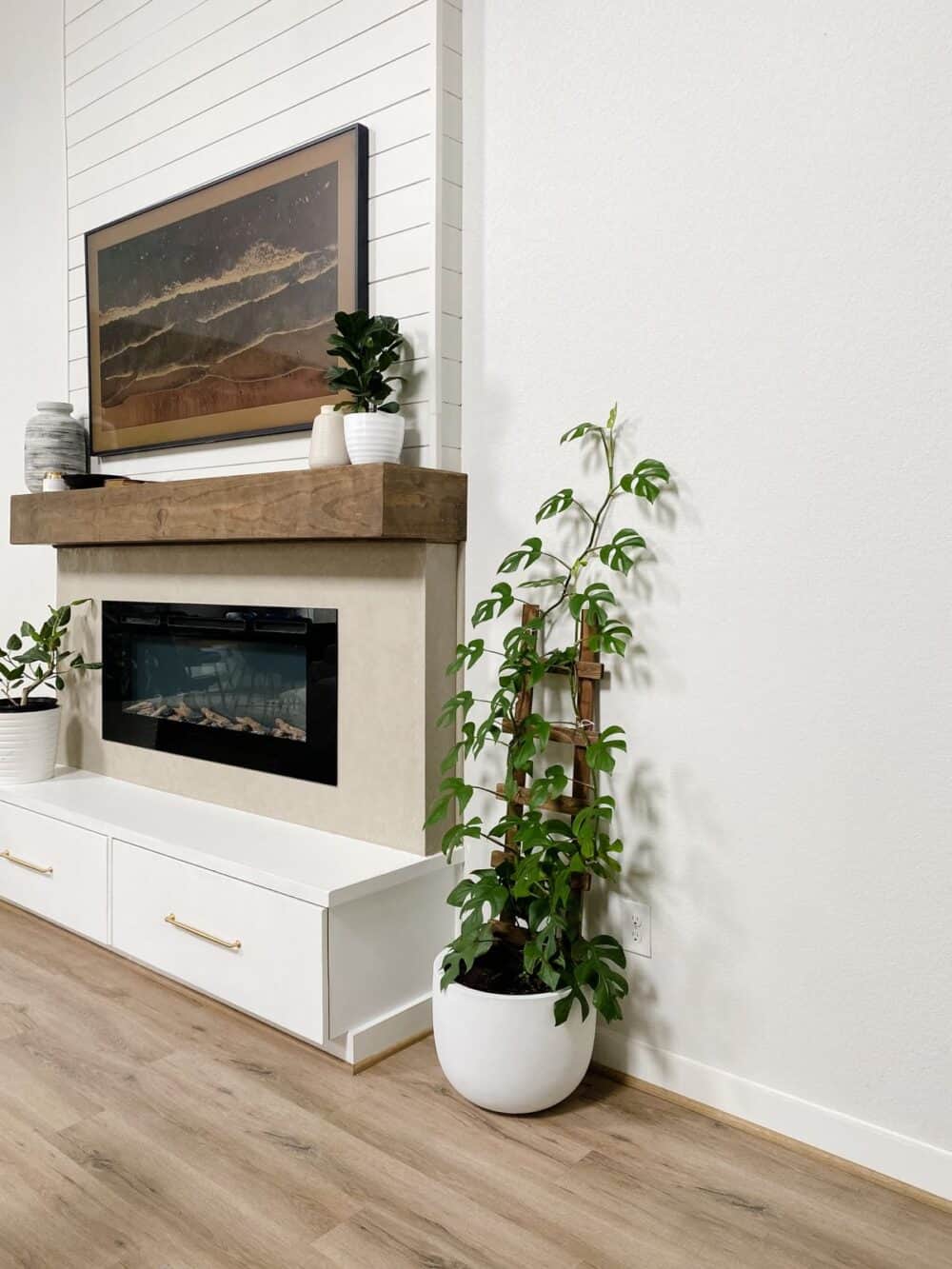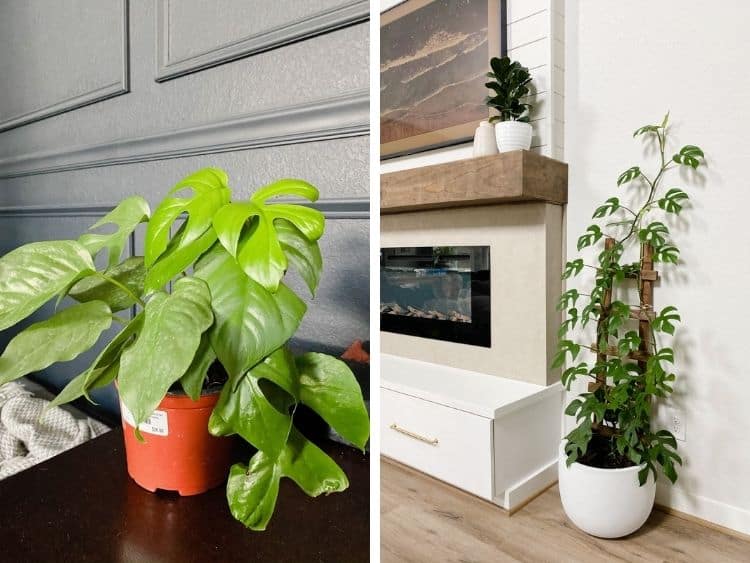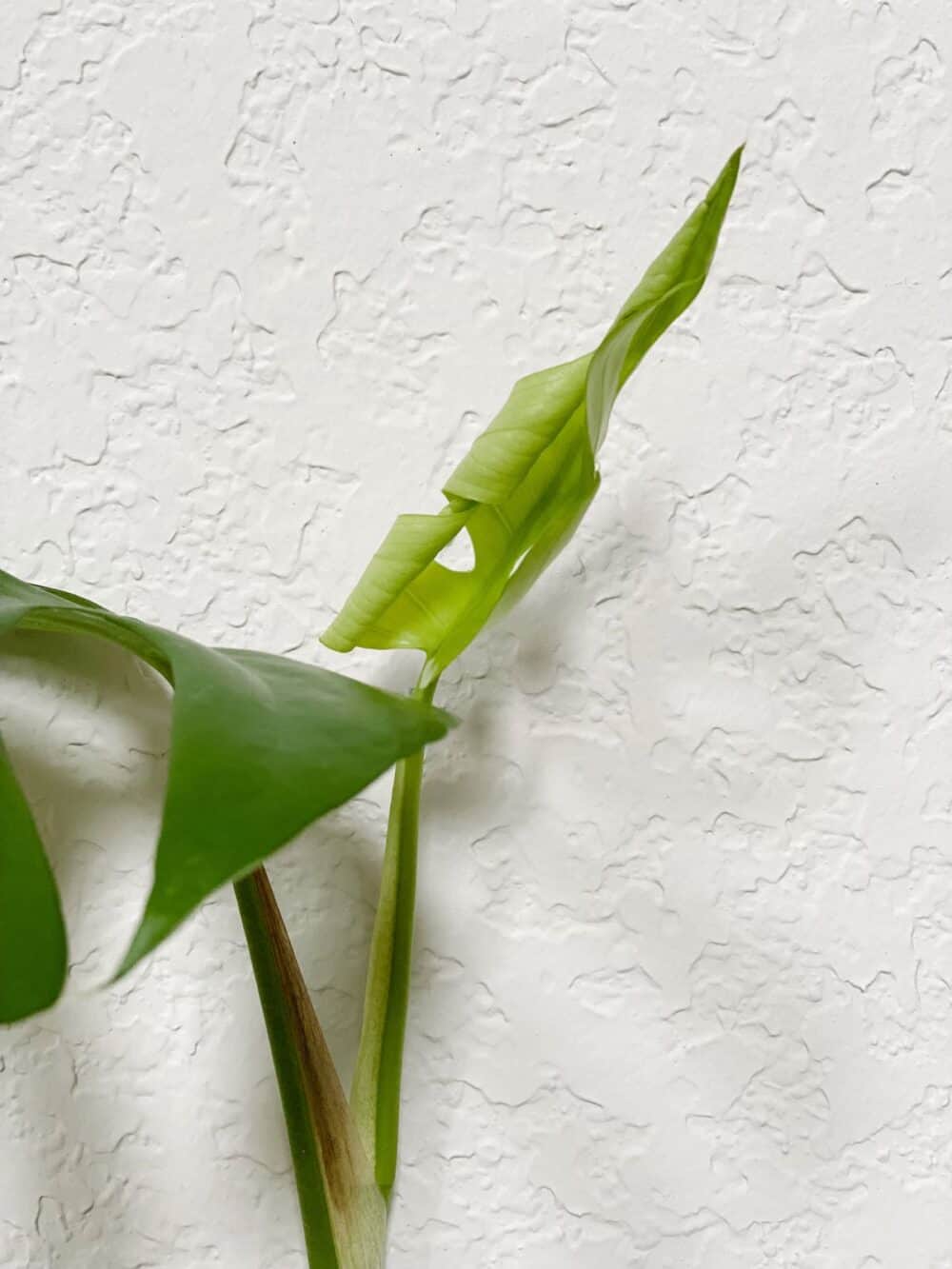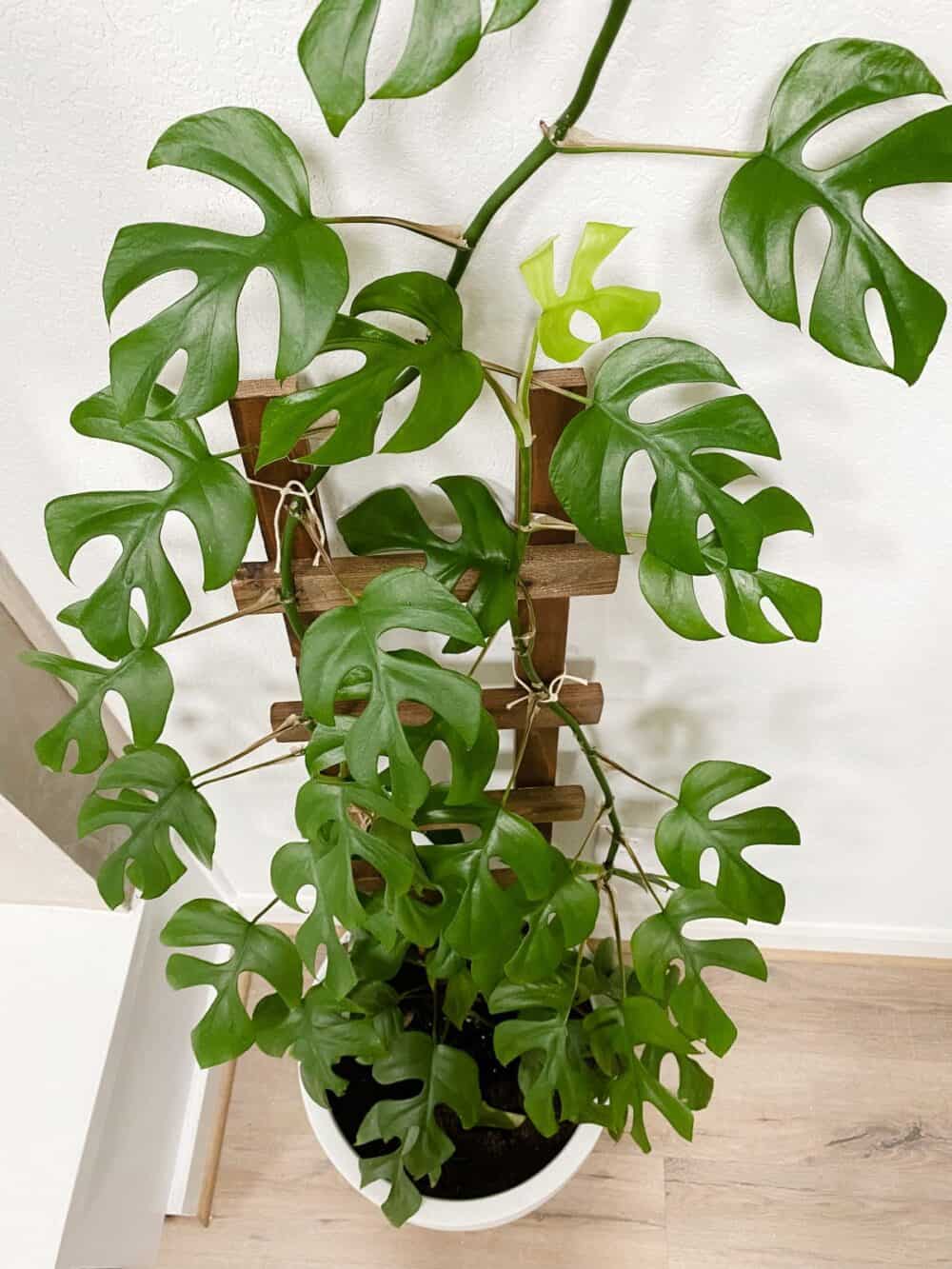Rhaphidophora Tetrasperma: A Deep Dive
Are you ready to learn everything you need to know about how to care for a Rhaphidophora Tetrasperma (AKA my favorite houseplant ever)?!

I stumbled upon the Rhaphidophora Tetrasperma last summer when I was first really getting into collecting plants for my home. It was labeled at my nursery as a “Mini Monstera,” and a Monstera was on my wish list, so I decided to grab it. It was a small little dude in a 6″ planter, so I plopped it on my nightstand and started to watch it grow.
And it grew. And grew. And grew.
Within a couple of months I realized it was definitely not a Monstera – it was needing some serious support to stay upright and it quickly reached a point where it just looked silly sitting on my nightstand because it was just so darn huge.
Don’t believe me? Here’s a little before and after – on the left is what the plant looked like on the day I got it (about one year ago). On the right is the plant today. Also, it’s worth noting I trimmed a solid 2+ feet worth of leaves from this guy before I moved it into the living room.

After some research, I finally realized I actually had a Rhaphidophora Tetrasperma, which is not a Monstera at all (despite the beautiful leaf fenestrations!) and I started learning more about how to take care of it.
It’s by far the most-asked-about plant in my house, and for good reason – it’s as tall as I am! So today, I figured we’d do a little deep dive on how to care for a Rhaphidophora Tetrasperma so you can feel confident getting one yourself!
how to care for a Rhaphidophora Tetrasperma
First of all, let’s tackle the elephant in the room – how the heck do you even pronounce Rhaphidophora Tetrasperma?!
It’s pronounced Rah-fid-oh-for-ah Teh-trah-SPERM-uh. It’s often mistaken for a Monstera or a Philodendron (it can commonly be called a Philodendron Ginny), but it’s not in the Monstera or Philodendron family at all. They’re in a category all on their own called Rhaphidophora, and one of their siblings is the Rhaphidophora Cryptantha, which is absolutely adorable and high on my list of must-have plants.
Now that you know what it is and how to say it, let’s get into the details of how to care for a Rhaphidophora Tetrasperma. They’re very easy to take care of and are generally pretty low maintenance, and they’re very rapid growers!

watering needs
Rhaphidophora Tetrasperma are low key in terms of watering needs – I water mine once weekly, and that’s all he needs to stay happy. Generally, you should let the first inch or two of soil dry out. They can handle a bit of both overwatering and underwatering, so don’t stress too much about water with these guys!
I also add some of this plant food to his water every week – this is a new addition, so he grew really well without it, but I anticipate that he’ll take off even more with the addition of the plant food!
Light needs
The Rhaphidophora Tetrasperma likes bright, indirect light and does not like the sun’s rays to hit it directly! They prefer a shadier area, and can handle lower light conditions than a lot of plants (though, they’ll grow faster and look healthier in a bright spot!).
I have mine across the room from a set of south-facing windows, so it gets indirect light pretty much all day long, and that has been a really great spot for it to be. My Rhaphidophora Tetrasperma also thrived when it was on my nightstand sitting right in front of a north-facing window.
Soil Needs
These plants aren’t too picky about their soil – I have mine planted in a regular ol’ cheap bag of soil from the garden center at my local hardware store and it’s doing just fine. But, if you want to pick the best option for your plant, you should go with a chunky, well-draining soil. You can mix 50% indoor potting mix with a combo of perlite, horticultural charcoal, and peat moss. I’m not that fancy with mine, though, and he’s pretty happy.
other Rhaphidophora Tetrasperma care tips
- They love humidity, so a bathroom would be a great spot for them, or just around a bunch of other plants!
- It might be tempting to let them trail instead of climb, but they can get really leggy and unhealthy if they trail too much. Give them a trellis and help them hold onto it and they’ll be much happier!
- In the right conditions, it can grow up to about 12′ tall!
- They can grow aerial roots, which helps them grab onto trellises or moss poles – but they probably will also need some support, so be prepared to tie them to your support!
is Rhaphidophora Tetrasperma toxic?
Yes! If your kids or pets are the type to try to take a bite out of your houseplants, you’ll want to keep your Rhaphidophora Tetrasperma out of reach.

propogating Rhaphidophora Tetrasperma
I haven’t had much success trying to propagate my Rhaphidophora Tetrasperma, but I hear it’s really easy so I’m sure it was user error! Also, I’ve refused to trim him back at all now that he’s really taking off so I guess we’ll never know.
To propagate it, all you need to do is take a stem cutting that has a leaf node on it and place it in water until roots start to grow! It can take a few weeks to start sprouting roots, so be patient with it!
potential Rhaphidophora Tetrasperma problems
Yellowing Leaves
This probably means it’s getting too much sun. Try moving it to a shadier spot or further away from your window. If you know that it’s not getting too much sun, your issue could also be overwatering!
Spider Mites
A common houseplant issue, they can be so frustrating! You can know you have spider mites if you start to see webbing on the underside of your leaves or small black thrips (a small bug) on the leaves. If you notice this, be sure to start treating with insecticide immediately, as they can be incredibly damaging to the plant.
No Fenestrations
If you’re worried because your Rhaphidophora Tetrasperma doesn’t have fenestrations (or holes in the leaves), don’t! It’s totally normal for a younger plant to not have fenestrations. They don’t develop until the plant starts to mature a bit, so give it some time and you’ll slowly start to see those beautiful fenestrations form!
The bottom line? The Rhaphidophora Tetrasperma is the best houseplant out there, in my personal opinion, and you should definitely buy one! It’s easy to care for, it’s beautiful, and it grows so satisfyingly fast!
Any other questions about this guy? Drop them in the comments and I’ll do my best to answer!

I love your posts,and your house, and your family! I’ve been reading since Wedding Bee days!
I have a skylight in the 12ft. ceiling in my bathroom. Would that be too much light for a Rhaphidophora Tetrasperma?
Hi Alice!!! I don’t think so – it wouldn’t love being directly under the skylight receiving direct sunlight, but being in a room with lots of indirect light would be the perfect environment!
I love the trellis you have for your RT! May I ask how you let it form/grow? Is it all one stem or did you “bend it” downward (rainbow shape)? Mine is getting larger and I want it to grow tall but maybe let it grow on wire to “decorate” the wall.
Thanks!
Mine has two stems! I’m currently working on propagating a third, but I have a hard time propagating this guy.
the lower leaves of the RT have fallen (a problem i am dealing with) however, i was wondering if i can plant in the soil the section that no longer has leaves so it doesn’t look bare. Any ideas?
Yes! I’m trying to do the same right now to make mine even fuller!
I have a beautiful propagated R.T sitting in a vase of water, with 5 new leaves and a substantial, impressive root system. I LOVE watching it grow under and over the water line.
But I worry about having to eventually pot this wondrous plant in soil. If I were to put a trellis behind the water-filled vase, could/should I just leave it in water? Will this stunt growth or will it remain happy/thriving in water forever? I also thought I had a monstera at first! I appreciate your post, thank you.
I haven’t ever tried growing it in just water – my guess is that it wouldn’t grow as large without soil, though. THey’re very hardy and I imagine it’ll transfer just fine!
My sister and I purchased a RHAPHIDOPHORA TETRASPERMA (copy n paste, what a great way to have correct spelling). It is just below a spiral staircase and gets indirect sun. When the first leave uncurled, we noticed a black spot that was on top n went through to the bottom. The next sprouting leave also had one. We decided to take the plant out of the soil, wash the roots n report it in new soil. Now there are 3 leaves that have turned yellow. We are thinking that just maybe we purchased this plant with a fungus or some health issue. We plan to return it.
Do you have ideas as to what we may have done wrong, what to do to prevent loosing the entire plant or, if you agree that it needs to be returned to Walmart?
Typically black or brown spots indicate a watering issue. My Rhaphidophora Tetrasperma does well with once-weekly watering, but you should always wait until the first 1-2″ are dry before watering. Could be over or underwatering, so I’d play with the watering schedule to see what happens! Also, the yellowing leaves could be from shock after messing with the roots – it’s pretty common for some leaves to yellow after a big thing like that!
I’d keep a close eye on your watering schedule for the next couple of weeks and see if it makes a difference! Of course, it’s hard to know for sure without seeing it and knowing the history – so if you’d feel better returning it, go for it!
How can I get a starter of this from you? I have checked everywhere here and can’t find one. Thank You!